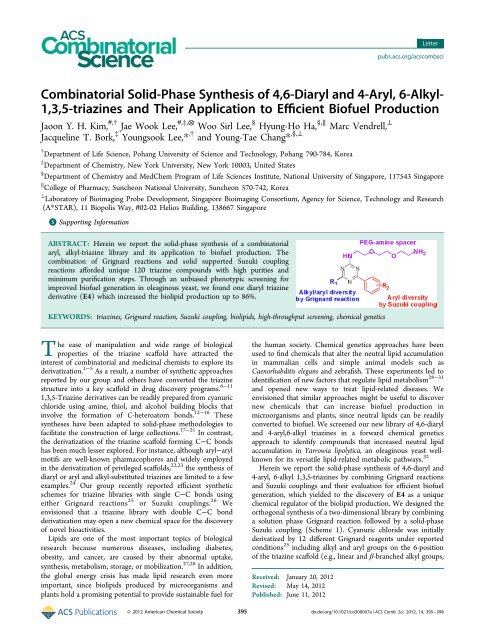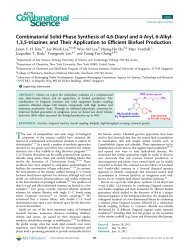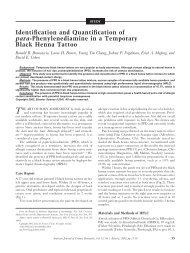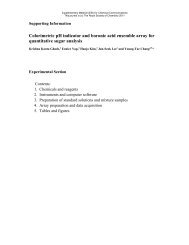Combinatorial Solid-Phase Synthesis of 4,6-Diaryl and 4-Aryl, 6-Alkyl
Combinatorial Solid-Phase Synthesis of 4,6-Diaryl and 4-Aryl, 6-Alkyl
Combinatorial Solid-Phase Synthesis of 4,6-Diaryl and 4-Aryl, 6-Alkyl
Create successful ePaper yourself
Turn your PDF publications into a flip-book with our unique Google optimized e-Paper software.
<strong>Combinatorial</strong> <strong>Solid</strong>-<strong>Phase</strong> <strong>Synthesis</strong> <strong>of</strong> 4,6-<strong>Diaryl</strong> <strong>and</strong> 4-<strong>Aryl</strong>, 6-<strong>Alkyl</strong>-<br />
1,3,5-triazines <strong>and</strong> Their Application to Efficient Bi<strong>of</strong>uel Production<br />
Jaoon Y. H. Kim, #,† Jae Wook Lee, #,‡,⊗ Woo Sirl Lee, § Hyung-Ho Ha, §,∥ Marc Vendrell, ⊥<br />
Jacqueline T. Bork, ‡ Youngsook Lee,* ,† <strong>and</strong> Young-Tae Chang* ,§,⊥<br />
†<br />
Department <strong>of</strong> Life Science, Pohang University <strong>of</strong> Science <strong>and</strong> Technology, Pohang 790-784, Korea<br />
‡<br />
Department <strong>of</strong> Chemistry, New York University, New York 10003, United States<br />
§<br />
Department <strong>of</strong> Chemistry <strong>and</strong> MedChem Program <strong>of</strong> Life Sciences Institute, National University <strong>of</strong> Singapore, 117543 Singapore<br />
∥<br />
College <strong>of</strong> Pharmacy, Suncheon National University, Suncheon 570-742, Korea<br />
⊥<br />
Laboratory <strong>of</strong> Bioimaging Probe Development, Singapore Bioimaging Consortium, Agency for Science, Technology <strong>and</strong> Research<br />
(A*STAR), 11 Biopolis Way, #02-02 Helios Building, 138667 Singapore<br />
*S Supporting Information<br />
ABSTRACT: Herein we report the solid-phase synthesis <strong>of</strong> a combinatorial<br />
aryl, alkyl-triazine library <strong>and</strong> its application to bi<strong>of</strong>uel production. The<br />
combination <strong>of</strong> Grignard reactions <strong>and</strong> solid supported Suzuki coupling<br />
reactions afforded unique 120 triazine compounds with high purities <strong>and</strong><br />
minimum purification steps. Through an unbiased phenotypic screening for<br />
improved bi<strong>of</strong>uel generation in oleaginous yeast, we found one diaryl triazine<br />
derivative (E4) which increased the biolipid production up to 86%.<br />
KEYWORDS: triazines, Grignard reaction, Suzuki coupling, biolipids, high-throughput screening, chemical genetics<br />
The ease <strong>of</strong> manipulation <strong>and</strong> wide range <strong>of</strong> biological<br />
properties <strong>of</strong> the triazine scaffold have attracted the<br />
interest <strong>of</strong> combinatorial <strong>and</strong> medicinal chemists to explore its<br />
derivatization. 1−5 As a result, a number <strong>of</strong> synthetic approaches<br />
reported by our group <strong>and</strong> others have converted the triazine<br />
structure into a key scaffold in drug discovery programs. 6−11<br />
1,3,5-Triazine derivatives can be readily prepared from cyanuric<br />
chloride using amine, thiol, <strong>and</strong> alcohol building blocks that<br />
involve the formation <strong>of</strong> C-heteroatom bonds. 12−16 These<br />
syntheses have been adapted to solid-phase methodologies to<br />
facilitate the construction <strong>of</strong> large collections. 17−21 In contrast,<br />
the derivatization <strong>of</strong> the triazine scaffold forming C−C bonds<br />
has been much lesser explored. For instance, although aryl−aryl<br />
motifs are well-known pharmacophores <strong>and</strong> widely employed<br />
in the derivatization <strong>of</strong> privileged scaffolds, 22,23 the synthesis <strong>of</strong><br />
diaryl or aryl <strong>and</strong> alkyl-substituted triazines are limited to a few<br />
examples. 24 Our group recently reported efficient synthetic<br />
schemes for triazine libraries with single C−C bonds using<br />
either Grignard reactions 25 or Suzuki couplings. 26 We<br />
envisioned that a triazine library with double C−C bond<br />
derivatization may open a new chemical space for the discovery<br />
<strong>of</strong> novel bioactivities.<br />
Lipids are one <strong>of</strong> the most important topics <strong>of</strong> biological<br />
research because numerous diseases, including diabetes,<br />
obesity, <strong>and</strong> cancer, are caused by their abnormal uptake,<br />
synthesis, metabolism, storage, or mobilization. 27,28 In addition,<br />
the global energy crisis has made lipid research even more<br />
important, since biolipids produced by microorganisms <strong>and</strong><br />
plants hold a promising potential to provide sustainable fuel for<br />
the human society. Chemical genetics approaches have been<br />
used to find chemicals that alter the neutral lipid accumulation<br />
in mammalian cells <strong>and</strong> simple animal models such as<br />
Caenorhabditis elegans <strong>and</strong> zebrafish. These experiments led to<br />
identification <strong>of</strong> new factors that regulate lipid metabolism 28−31<br />
<strong>and</strong> opened new ways to treat lipid-related diseases. We<br />
envisioned that similar approaches might be useful to discover<br />
new chemicals that can increase bi<strong>of</strong>uel production in<br />
microorganisms <strong>and</strong> plants, since neutral lipids can be readily<br />
converted to bi<strong>of</strong>uel. We screened our new library <strong>of</strong> 4,6-diaryl<br />
<strong>and</strong> 4-aryl,6-alkyl triazines in a forward chemical genetics<br />
approach to identify compounds that increased neutral lipid<br />
accumulation in Yarrowia lipolytica, an oleaginous yeast wellknown<br />
for its versatile lipid-related metabolic pathways. 32<br />
Herein we report the solid-phase synthesis <strong>of</strong> 4,6-diaryl <strong>and</strong><br />
4-aryl, 6-alkyl 1,3,5-triazines by combining Grignard reactions<br />
<strong>and</strong> Suzuki couplings <strong>and</strong> their evaluation for efficient bi<strong>of</strong>uel<br />
generation, which yielded to the discovery <strong>of</strong> E4 as a unique<br />
chemical regulator <strong>of</strong> the biolipid production. We designed the<br />
orthogonal synthesis <strong>of</strong> a two-dimensional library by combining<br />
a solution phase Grignard reaction followed by a solid-phase<br />
Suzuki coupling (Scheme 1). Cyanuric chloride was initially<br />
derivatized by 12 different Grignard reagents under reported<br />
conditions 25 including alkyl <strong>and</strong> aryl groups on the 6-position<br />
<strong>of</strong> the triazine scaffold (e.g., linear <strong>and</strong> β-branched alkyl groups,<br />
Received: January 20, 2012<br />
Revised: May 14, 2012<br />
Published: June 11, 2012<br />
Letter<br />
pubs.acs.org/acscombsci<br />
© 2012 American Chemical Society 395 dx.doi.org/10.1021/co300007a | ACS Comb. Sci. 2012, 14, 395−398
ACS <strong>Combinatorial</strong> Science Letter<br />
Scheme 1. <strong>Synthesis</strong> <strong>of</strong> 4,6-<strong>Diaryl</strong> <strong>and</strong> 4-<strong>Aryl</strong>, 6-<strong>Alkyl</strong>-1,3,5triazine<br />
Compounds a<br />
a Reagents <strong>and</strong> conditions: (a) R1-MgX, THF, 0 °C to r.t., 8 h; (b)<br />
PAL-PS amine-derivatized resin, THF, DIEA, 60 °C, 3 h; (c)<br />
Pd(PPh 3) 4, dioxane, R 2-B(OH) 2,Cs 2CO 3,90°C, 15 h; (d) TFA-<br />
DCM (1:9), r.t., 0.5 h.<br />
Figure 1. Building blocks for library synthesis: (a) Grignard reagents,<br />
(b) boronic acids.<br />
differently substituted aromatic rings, Figure 1a). The resulting<br />
2,4-dichloro-6-alkyl-1,3,5-triazines were loaded onto an aminederivatized<br />
PAL-polystyrene (PAL-PS) resin to accelerate their<br />
further combinatorial derivatization. 33 PAL-PS resins are<br />
compatible with palladium-catalyzed cross-coupling conditions,<br />
34−36 <strong>and</strong> have been used for the preparation <strong>of</strong> taggedtriazine<br />
libraries. 6−8<br />
Polymer-supported triazines were then derivatized using<br />
optimized Suzuki coupling conditions 26 with 10 different<br />
boronic acids that included both electron-withdrawing <strong>and</strong><br />
electron-donating groups (Figure 1b). A final acidic cleavage<br />
with a trifluoroacetic acid-dichloromethane solution (1:9)<br />
rendered a collection <strong>of</strong> 4,6-diaryl <strong>and</strong> 4-aryl, 6-alkyl 1,3,5triazines<br />
(120 compounds) in average purities around 90%<br />
without running any purification step (Supporting Information,<br />
Table S1).<br />
Next we examined the library in a chemical genetics<br />
approach for efficient bi<strong>of</strong>uel generation. To identify triazine<br />
compounds that promoted lipid accumulation in Y. lipolyica, we<br />
cultured the cells to midlog phase, treated them with the<br />
individual compounds <strong>of</strong> the library, <strong>and</strong> analyzed their neutral<br />
lipid content by staining the cells with a lipid sensing<br />
fluorescent BODIPY dye (D3922, Invitrogen). 37 In this<br />
396<br />
Figure 2. (a) Chemical structures <strong>of</strong> E4 <strong>and</strong> the analogues E4OH <strong>and</strong><br />
E4Bz; (b) Fluorescent microscope images <strong>of</strong> BODIPY-stained Y.<br />
lipolytica cells treated with DMSO (left) <strong>and</strong> 10 μM <strong>of</strong>E4(right).<br />
Cells were grown for 12 h at 28 °C in an air-shaking incubator (180<br />
rpm) after being treated with DMSO or E4; (c) BODIPY fluorescence<br />
average intensity <strong>of</strong> cells treated with E4, E4OH, E4Bz <strong>and</strong> DMSO (10<br />
μM) (n = 3, bars as SD). The same number <strong>of</strong> cells (OD 600 = 0.5) was<br />
used for all the experiments.<br />
screening we found that only one triazine compound (E4,<br />
Figure 2a) induced a significant increase <strong>of</strong> the lipid production,<br />
with a fluorescence intensity enhancement up to 86% at 10 μM<br />
(Figure 2b). Furthermore, we observed that that none <strong>of</strong> the<br />
single C−C bond triazine derivatives from previously<br />
synthesized libraries (588 Grignard 25 <strong>and</strong> 160 Suzuki<br />
derivatives 26 ) showed any significant activity, asserting the<br />
unique biochemical properties <strong>of</strong> the newly synthesized<br />
triazines. To examine the role that the ethyleneglycol group<br />
played in the activity <strong>of</strong> E4, we synthesized <strong>and</strong> tested two<br />
analogues with shorter <strong>and</strong> aromatic versions <strong>of</strong> the linker (i.e.,<br />
respectively E4OH <strong>and</strong> E4Bz, Figure 2a). All three compounds<br />
showed a similar dose-dependent increase <strong>of</strong> the lipid<br />
accumulation (Supporting Information, Figure S4), which<br />
indicated the substituted diaryl triazine core as the main one<br />
responsible for the biological activity. Moreover, none <strong>of</strong> these<br />
compounds did show substantial toxicity or inhibition <strong>of</strong> the<br />
cell growth, even at high concentration. Finally, we determined<br />
the amount <strong>of</strong> triacylglycerol (TAG) extracted from the same<br />
number <strong>of</strong> cells treated with E4, E4OH, <strong>and</strong> E4Bz <strong>and</strong><br />
compared it to DMSO-treated control cells. This experiment<br />
confirmed the capacity <strong>of</strong> E4 <strong>and</strong> its analogues to increase the<br />
content <strong>of</strong> TAG (Supporting Information, Figure S4a). The<br />
dx.doi.org/10.1021/co300007a | ACS Comb. Sci. 2012, 14, 395−398
ACS <strong>Combinatorial</strong> Science Letter<br />
amount <strong>of</strong> biochemically extracted TAG was quantified by<br />
densitometry on iodine-stained TLC plates, <strong>and</strong> corroborated<br />
the results obtained by fluorescence staining. These results<br />
proved the application <strong>of</strong> 4,6-diaryl 1,3,5-triazines as c<strong>and</strong>idate<br />
molecules to increase lipid accumulation in Y. lipolytica.<br />
In conclusion, we prepared in solid-phase a collection <strong>of</strong> 4,6diaryl<br />
<strong>and</strong> 4-aryl, 6-alkyl 1,3,5-triazines using Grignard reactions<br />
<strong>and</strong> Suzuki couplings <strong>and</strong> performed an unbiased phenotypic<br />
screening to discover E4 as a unique small molecule with<br />
efficient biolipid generation activity. Further biochemical<br />
studies toward target identification <strong>and</strong> mechanism elucidation<br />
will<br />
■<br />
be reported in due course.<br />
ASSOCIATED CONTENT<br />
*S Supporting Information<br />
Synthetic procedures for the library synthesis, characterization<br />
data for the hit compounds <strong>and</strong> procedures for the bioassays.<br />
This material is available free <strong>of</strong> charge via the Internet at<br />
http://pubs.acs.org.<br />
■ AUTHOR INFORMATION<br />
Corresponding Author<br />
*E-mail: ylee@postech.ac.kr (Y.L.), chmcyt@nus.edu.sg (Y.-<br />
T.C.). fax: +82 542792199 (Y.L.), +65 67791691 (Y.-T.C.).<br />
Phone: +82 542792296 (Y.L.), +65 65166774 (Y.-T.C.).<br />
Present Address<br />
⊗<br />
The Scripps Research Institute, SR207 10550 North Torrey<br />
Pines Road, SR202 La Jolla, CA 92037.<br />
Author Contributions<br />
#<br />
These authors contributed equally to this work.<br />
Author Contributions<br />
Y.S.L. <strong>and</strong> Y.T.C. conceived <strong>and</strong> designed the research <strong>and</strong><br />
wrote the manuscript. J.Y.H.K. performed the biological<br />
experiments <strong>and</strong> wrote the manuscript. J.W.L., W. S.L., H.-<br />
H.H., <strong>and</strong> M.V. performed organic synthesis <strong>and</strong> wrote the<br />
manuscript. J.T.B. carried out organic synthesis. All authors<br />
have given approval to the final version <strong>of</strong> the manuscript.<br />
Funding<br />
The authors are grateful to A*STAR SSCC Grant (SSCC10/<br />
024) <strong>and</strong> the Global Frontier Program (2010-0029723) <strong>of</strong> the<br />
Ministry <strong>of</strong> Education, Science <strong>and</strong> Technology <strong>of</strong> Korea for<br />
the financial support.<br />
Notes<br />
The authors declare no competing financial interest.<br />
■ REFERENCES<br />
(1) Lee, H. K.; Chui, W. K. <strong>Combinatorial</strong> Mixture <strong>Synthesis</strong> <strong>and</strong><br />
Biological Evaluation <strong>of</strong> Dihydrophenyl Triazine Antifolates. Bioorg.<br />
Med. Chem. 1999, 7, 1255−1262.<br />
(2) Zhou, C.; Min, J.; Liu, Z.; Young, A.; Deshazer, H.; Gao, T.;<br />
Chang, Y. T.; Kallenbach, N. R. <strong>Synthesis</strong> <strong>and</strong> biological evaluation <strong>of</strong><br />
novel 1,3,5-triazine derivatives as antimicrobial agents. Bioorg. Med.<br />
Chem. Lett. 2008, 18, 1308−1311.<br />
(3) Vu, C. B.; Pan, D.; Peng, B.; Kumaravel, G.; Smits, G.; Jin, X.;<br />
Phadke, D.; Engber, T.; Huang, C.; Reilly, J.; Tam, S.; Grant, D.; Hetu,<br />
G.; Petter, R. C. Novel Diamino Derivatives <strong>of</strong> [1,2,4]-triazolo[1,5a][1,3,5]triazine<br />
as Potent <strong>and</strong> Selective Adenosine A2a Receptor<br />
Antagonists. J. Med. Chem. 2005, 48, 2009−2018.<br />
(4) Lee, H. K.; Rana, T. M. Microwave-Assisted Parallel <strong>Synthesis</strong> <strong>of</strong><br />
a 4,6-Diamino-2,2-dimethyl-1,2-dihydro-1-phenyl-s-triazine Library. J.<br />
Comb. Chem. 2004, 6, 504−508.<br />
(5) Henke, B. R.; Consler, T. G.; Go, N.; Hale, R. L.; Hohman, D. R.;<br />
Jones, S. A.; Lu, A. T.; Moore, L. B.; Moore, J. T.; Orb<strong>and</strong>-Miller, L.<br />
397<br />
A.; Robinett, R. G.; Shearin, J.; Spearing, P. K.; Stewart, E. L.;<br />
Turnbull, P. S.; Weaver, S. L.; Williams, S. P.; Wisely, G. B.; Lambert.,<br />
M. H. A New Series <strong>of</strong> Estrogen Receptor Modulators That Display<br />
Selectivity for Estrogen Receptor β. J. Med. Chem. 2002, 45, 5492−<br />
5505.<br />
(6) Moon, H. S.; Jacobson, E. M.; Khersonsky, S. M.; Luzung, M. R.;<br />
Walsh, D. P.; Xiong, W.; Lee, J. W.; Parikh, P. B.; Lam, J. C.; Kang, T.<br />
W.; Rosania, G. R.; Schier, A. F.; Chang, Y. T. A Novel Microtubule<br />
Destabilizing Entity from Orthogonal <strong>Synthesis</strong> <strong>of</strong> Triazine Library<br />
<strong>and</strong> Zebrafish Embryo Screening. J. Am. Chem. Soc. 2002, 124, 11608−<br />
11609.<br />
(7) Williams, D.; Jung, D. W.; Khersonsky, S. M.; Heidary, N.;<br />
Chang, Y. T.; Orlow, S. J. Identification <strong>of</strong> Compounds that Bind<br />
Mitochondrial F1F0 ATPase by Screening a Triazine Library for<br />
Correction <strong>of</strong> Albinism. Chem. Biol. 2004, 11, 1251−1259.<br />
(8) Khersonsky, S. M.; Jung, D. W.; Kang, T. W.; Walsh, D. P.;<br />
Moon, H. S.; Jo, H.; Jacobson, E. M.; Shetty, V.; Neubert, T. A.;<br />
Chang, Y. T. Facilitated Forward Chemical Genetics Using Tagged<br />
Triazine Library <strong>and</strong> Zebrafish Embryo Screening. J. Am. Chem. Soc.<br />
2003, 125, 11804−11805.<br />
(9) Guo, Z.; Wu, D.; Zhu, Y. F.; Tucci, F. C.; Pontillo, J.; Saunders, J.;<br />
Xie, Q.; Struthers, R. S.; Chen, C. A. Convenient One-pot <strong>Synthesis</strong> <strong>of</strong><br />
Asymmetric 1,3,5-Triazine-2,4,6-triones <strong>and</strong> its Application Towards a<br />
Novel Class <strong>of</strong> Gonadotropin-releasing Hormone Receptor Antagonists.<br />
Bioorg. Med. Chem. Lett. 2005, 15, 693−698.<br />
(10) Balboni, G.; Lazzari, I.; Trapella, C.; Negri, L.; Lattanzi, R.;<br />
Giannini, E.; Nicotra, A.; Melchiorri, P.; Visentin, S.; De Nuccio, C.;<br />
Salvadori, S. Triazine Compounds as Antagonists at Bv8-Prokineticin<br />
Receptors. J. Med. Chem. 2008, 51, 7635−7639.<br />
(11) Krecmerová, M.; Holý, A.; Pískala, A.; Masojídková, M.; Andrei,<br />
G.; Naesens, L.; Neyts, J.; Balzarini, J.; Clercq, E.; De; Snoeck, R.<br />
Antiviral Activity <strong>of</strong> Triazine Analogues <strong>of</strong> 1-(S)-[3-Hydroxy-2-<br />
(phosphonomethoxy)propyl]cytosine (Cid<strong>of</strong>ovir) <strong>and</strong> Related Compounds.<br />
J. Med. Chem. 2007, 50, 1069−1077.<br />
(12) Kido, H.; Goodrow, M. H.; Griffeth, V.; Lucas, A. D.; Gee, S. J.;<br />
Hammock, B. D. Development <strong>of</strong> an Enzyme-linked Immunosorbent<br />
Assay for the Detection <strong>of</strong> Hydroxytriazines. J. Agric. Food Chem. 1997,<br />
45, 414−424.<br />
(13) Lippa, K.; Roberts, A. Nucleophilic Aromatic Substitution<br />
Reactions <strong>of</strong> Chloroazines with Bisulfide (HS-) <strong>and</strong> Polysulfides (Sn2-<br />
). Environ. Sci. Technol. 2002, 36, 2008−2018.<br />
(14) Chen, Y.; Wang, D. X.; Huang, Z. T.; Wang, M. X. <strong>Synthesis</strong>,<br />
Structure, <strong>and</strong> Functionalization <strong>of</strong> Homo Heterocalix[2]arene[2]triazines:<br />
Versatile Conformation <strong>and</strong> Cavity Structures Regulated by<br />
the Bridging Elements. J. Org. Chem. 2010, 75, 3786−3796.<br />
(15) Umali, A. P.; Crampton, H. L.; Simanek, E. E. Triazine<br />
Dendrimers with Orthogonally Protected Amines on the Periphery.<br />
Masking Amines with Dde <strong>and</strong> BOC Groups Provides an Alternative<br />
to Carrying Protected Alcohols <strong>and</strong> Disulfides through an Iterative<br />
<strong>Synthesis</strong>. J. Org. Chem. 2007, 72, 9866−9874.<br />
(16) Lim, J.; Mintzer, M. A.; Perez, L. M.; Simanez, E. E. <strong>Synthesis</strong> <strong>of</strong><br />
Odd Generation Triazine Dendrimers Using a Divergent, Macromonomer<br />
Approach. Org. Lett. 2010, 12, 1148−1151.<br />
(17) Gopalsamy, A.; Yang, H. <strong>Combinatorial</strong> <strong>Synthesis</strong> <strong>of</strong> Heterocycles:<br />
<strong>Solid</strong>-<strong>Phase</strong> <strong>Synthesis</strong> <strong>of</strong> 6-Amino-2,4-dioxo-3,4-dihydro-1,3,5triazine<br />
Derivatives. J. Comb. Chem. 2001, 3, 278−283.<br />
(18) Bork, J. T.; Lee, J. W.; Khersonsky, S. M.; Moon, H. S.; Chang,<br />
Y. T. Novel Orthogonal Strategy toward <strong>Solid</strong> <strong>Phase</strong> <strong>Synthesis</strong> <strong>of</strong><br />
1,3,5-Substituted Triazines. Org. Lett. 2003, 5, 117−120.<br />
(19) Khersonsky, S. M.; Chang, Y. T. Safety-Catch Approach to<br />
Orthogonal <strong>Synthesis</strong> <strong>of</strong> Triazine Library. J. Comb. Chem. 2004, 6,<br />
474−477.<br />
(20) Hu, Z.; Ma, T.; Chen, Z.; Ye, Z.; Zhang, G.; Lou, Y.; Yu, Y.<br />
<strong>Solid</strong>-<strong>Phase</strong> <strong>Synthesis</strong> <strong>and</strong> Antitumor Evaluation <strong>of</strong> 2,4-Diamino-6aryl-1,3,5-triazines.<br />
J. Comb. Chem. 2009, 11, 267−273.<br />
(21) Kong, K. H.; Tan, C. K.; Lam, Y. Traceless <strong>Solid</strong>-<strong>Phase</strong><br />
<strong>Synthesis</strong> <strong>of</strong> 6-Amino- <strong>and</strong> 6-Hydroxyimino-1,3,5-triazine-2,4-diones<br />
<strong>and</strong> 1,3,5-Triazine-2,4,6-triones. J. Comb. Chem. 2009, 11, 1050−1060.<br />
dx.doi.org/10.1021/co300007a | ACS Comb. Sci. 2012, 14, 395−398
ACS <strong>Combinatorial</strong> Science Letter<br />
(22) Tounge, B. A.; Reynolds, C. H. Defining Privileged Reagents<br />
Using Subsimilarity Comparison. J. Chem. Inf. Comput. Sci. 2004, 44,<br />
1810−1815.<br />
(23) Tejedor, D.; Garcia-Tellado, F. Chemo-differentiating ABB′<br />
Multicomponent Reactions. Privileged Building Blocks. Chem. Soc. Rev.<br />
2007, 36, 484−491.<br />
(24) Konno, S.; Osawa, N.; Yamanaka, H. <strong>Synthesis</strong> <strong>of</strong> 6-Substituted<br />
3,5-<strong>Diaryl</strong>-1,2,4-triazines as Potential Herbicidal Agents. J. Agric. Food<br />
Chem. 1995, 43, 838−842.<br />
(25) Lee, J. W.; Bork, J. T.; Ha, H. H.; Samanta, A.; Chang, Y. T.<br />
Novel Orthogonal <strong>Synthesis</strong> <strong>of</strong> Tagged <strong>Combinatorial</strong> Triazine<br />
Library via Grignard Reaction. Aus. J. Chem. 2009, 62, 1000−1006.<br />
(26) Lee, J. W.; Ha, H. H.; Vendrell, M.; Bork, J. T.; Chang, Y. T.<br />
<strong>Combinatorial</strong> <strong>Solid</strong>-<strong>Phase</strong> <strong>Synthesis</strong> <strong>of</strong> 6-aryl-1,3,5-triazines via<br />
Suzuki Coupling. Aus. J. Chem. 2011, 64, 540−544.<br />
(27) Kawasumi, M.; Nghiem, P. Chemical Genetics: Elucidating<br />
Biological Systems with Small Molecules. J. Invest. Dermatol. 2007,<br />
127, 1577−1584.<br />
(28) Lemieux, G. A.; Liu, J.; Mayer, N.; Bainton, R. J.; Ashrafi, K.;<br />
Werb, Z. A Whole-organism Screen Identifies New Regulators <strong>of</strong> Fat<br />
Storage. Nat. Chem. Biol. 2011, 7, 206−213.<br />
(29) Ishitsukal, R.; Saito, T.; Osada, H.; Ohno-Iwashita, Y.;<br />
Kobayashi, T. Fluorescence Image Screening for Chemical Compounds<br />
Modifying Cholesterol Metabolism <strong>and</strong> Distribution. J. Lipid<br />
Res. 2011, 52, 2084−2094.<br />
(30) Murphy, S.; Martin, S.; Parton, R. G. Quantitative Analysis <strong>of</strong><br />
Lipid Droplet Fusion: Inefficient Steady State Fusion but Rapid<br />
Stimulation by Chemical Fusogens. PLoS One 2010, 5, e15030.<br />
(31) Clifton, J. D.; Lucumi, E.; Myers, M. C.; Napper, A.; Hama, K.;<br />
Farber, S. A.; Smith, A. B.; Huryn, D. M.; Diamond, S. L.; Pack, M.<br />
Identification <strong>of</strong> Novel Inhibitors <strong>of</strong> Dietary Lipid Absorption Using<br />
Zebrafish. PLoS One 2010, 5, e12386.<br />
(32) Beopoulos, A.; Cescut, J.; Haddouche, R.; Uribelarrea, J. L.;<br />
Molina-Jouve, C.; Nicaud, J. M. Yarrowia lipolytica as a Model for Biooil<br />
Production. Prog. Lipid Res. 2009, 48, 375−387.<br />
(33) Albericio, F.; Barany, G. Acidolytic Cleavage <strong>of</strong> Tris(alkoxy)benzylamide<br />
(PAL) “internal reference” Amino Acyl (IRAA)<br />
Anchoring Linkages: Validation <strong>of</strong> Accepted Procedures in <strong>Solid</strong>-<br />
<strong>Phase</strong> Peptide <strong>Synthesis</strong> (SPPS). Int. J. Pept. Protein Res. 1993, 41,<br />
307−312.<br />
(34) Gauthier, D. R., Jr.; Limanto, J.; Devine, P. N.; Desmond, R. A.;<br />
Szumigala, R. H., Jr.; Foster, B. S.; Volante, R. P. Palladium-Catalyzed<br />
Regioselective <strong>Aryl</strong>ation <strong>of</strong> Imidazo[1,2-b][1,2,4]triazine: <strong>Synthesis</strong> <strong>of</strong><br />
an α 2/3-Selective GABA Agonist. J. Org. Chem. 2005, 70, 5938−5945.<br />
(35) Kuo, G. H.; DeAngelis, A.; Emanuel, S.; Wang, A.; Zhang, Y.;<br />
Connolly, P. J.; Chen, X.; Gruninger, R. H.; Rugg, C.; Fuentes-<br />
Pesquera, A.; Middleton, S. A.; Jolliffe, L.; Murray, W. V. <strong>Synthesis</strong> <strong>and</strong><br />
Identification <strong>of</strong> [1,3,5]Triazine-pyridine Biheteroaryl as a Novel<br />
Series <strong>of</strong> Potent Cyclin-Dependent Kinase Inhibitors. J. Med. Chem.<br />
2005, 48, 4535−4546.<br />
(36) Garnier, E.; Audoux, J.; Pasquinet, E.; Suzenet, F.; Poullain, D.;<br />
Lebret, B.; Guillaumet, G. Easy Access to 3- or 5-Heteroarylamino-<br />
1,2,4-triazines by S NAr, S NH, <strong>and</strong> Palladium-Catalyzed N-Heteroarylations.<br />
J. Org. Chem. 2004, 69, 7809−7815.<br />
(37) Bozaquel-Morais, B. L.; Madeira, J. B.; Maya-Monteiro, C. M.;<br />
Masuda, C. A.; Montero-Lomeli, M. A New Fluorescence-based<br />
Method Identifies Protein Phosphatases Regulating Lipid Droplet<br />
Metabolism. PLoS One 2010, 5, e13692.<br />
398<br />
dx.doi.org/10.1021/co300007a | ACS Comb. Sci. 2012, 14, 395−398






